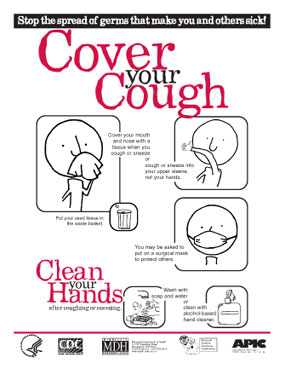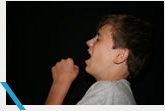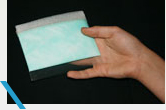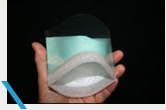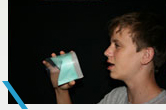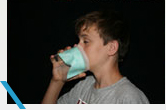Cover Your Cough

The advice contained in this "germ containment strategy" is simply not always feasible (and is, therefore, sometimes ineffective) for several reasons. A person with a respiratory illness is not likely to have the luxury of being next to a waste can and a sink whenever coughing or sneezing occurs. (Reference air travel.) Secondly, a cough or sneeze is not usually an isolated incident, but occurs over and over. It is simply not feasible to wash one's hands or apply hand cleanser after every cough. For that matter the skin of the hands is not likely to stand up well to this sort of rough use. Furthermore, if one coughs into one's sleeve (assuming one has sleeves) it soon becomes a culprit in the spread of germs acting as a handy reservoir until it sees the laundry. In terms of using a tissue to cover the mouth during a cough or sneeze, it can hardly take the strain of a single cough and can't be counted upon to protect the hand from contamination. Who will leave the flu virus on the nearest doorknob? Tissues and handkerchiefs are also not properly shaped to "catch a cough."
Experts agree that an integral part of respiratory disease transmission prevention is reduction of aerosolized droplets infected with viral, bacterial or mycobacterial (tuberculosis) organisms. In some cases isolation of sick individuals is taken so far as to isolate and clean the very air they breathe. The currently readily available strategy which might have the greatest chance of working to contain airborne, "cough-spread" illness is the widespread wearing of respirators, or less effective, surgical masks, contained in the footnote to the advice put forth by the CDC. In some countries and communities where increased incidence of SARS has been a justifiable concern, masks have been worn by some sick persons, but even more frequently by well persons for self protection. Perhaps because of the stigma associated with wearing a mask, and the feeling of confinement they induce, the strategy of wearing a mask when one is sick simply does not happen much in most countries. In "free societies," we are not likely to see any sort of enforced policy mandating such use. Widespread use of masks has the potential to curtail disease spread, but compliance among the population is lacking, despite perceived efficacy, accessibility, and low cost. Even the CDC is reluctant to take the step of recommending use of masks for those with cough. Even if masks were routinely worn by coughing individuals, the type of mask worn is unlikely to have an effective "respirator-type" seal which would be necessary to trap rather than disperse aerosolized droplets around the edges of the mask. The CDC has put forth the opinion that little is known in terms of efficacy of these of masks for disease prevention, at least in the case of influenza.http://www.cdc.gov/flu/professionals/infectioncontrol/maskguidance.htm
So we are left with the sleeve and tissue! This is why we created Coughcatcher® - it's the better tissue! Created by a physician member of APIC (Association for Professionals in Infection Control and Epidemiology), this device is an outer (expandable) sheath containing an inner filter element which is similar to a surgical mask. The soft contoured mouth of the device is designed to form an effective seal on the face during application. It is basically a cough-catching filter in a flattened plastic sheath. The idea is that the person with a cough pulls the device out of his pocket and coughs into it. The aerosolized droplets are "caught" in the filter element, and the hand is protected by the plastic sheath. The Coughcatcher® can then be put back in the pocket. The need to wash one's hands is greatly reduced, and the environment is better protected. The device is meant to be short-term reusable (all day), costing about the same as a small box of tissue. It can be used to "snatch a sneeze," too.
The design of this product allows for several beneficial factors to occur.
- Coughcatcher® is more durable than tissue for trapping respiratory droplets. Airborne respiratory droplets can contain viral, bacterial, and mycobacterial (tuberculosis) pathogens found in emissions related to coughing.
- Coughcatcher® provides a means to dramatically reduce contamination to one's hands and clothing and surroundings related to coughing. The filter element, contaminated by respiratory secretions, is kept contained inside the plastic sheathe; and much of these secretions remain trapped within the filter and sheath. The user's hands are not as contaminated with repetitive coughing. The need for handwashing is greatly reduced.
- Coughcatcher® is a very easy-to-use and cost-effective device, soon to be commonly available. A modest retail price will not encourage use beyond the appropriate life span and will encourage the gifting of the device to the appropriate coughing patient.
- Coughcatcher® has wide applicability, both for self purchase and for distribution to others who are coughing as a preferred alternative to less effective and less acceptable methods such as tissues and surgical masks.
- Coughcatcher® provides a discreet solution for the patient with a cough. It is small and flat enough to be carried in a shirt or hip pocket or purse, or even tucked between the pages of a book.
- With Coughcatcher®, the individual with a cough has the ability to be effectively proactive. It does not alert others to illness as would a mask, causing avoidance behavior. Compared to traditional strategies, Coughcatcher® better allows the patient with a cough to get back into the population or back to work or school when feeling well enough.

